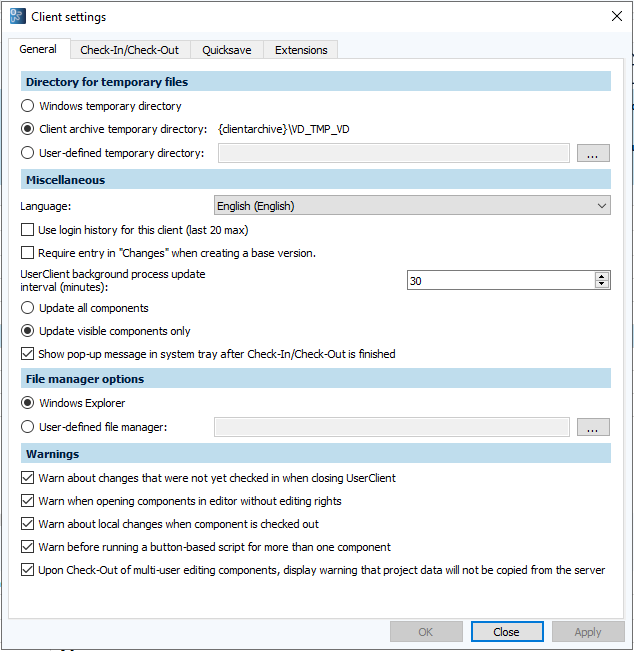General tab

Directory for temporary files
In this section, you define in which directory temporary files that are created while working with octoplant are to be stored. You have the following options:
-
Temporary Window's directory,
-
the default directory in the client archive of octoplant or
-
a user-defined directory.
For the user-defined directory, you can select a path in the file system.
Miscellaneous
-
Language: Here, you specify the language in which the clients are displayed. Alternatively, you can also change the language using the <Language> dropdown menu in the Extras tab located in the menu bar. This is described in the section Language selection.
The BackupClient language is configured directly in the application itself and is independent of this. -
Use login history for this client (last 20 max): If you check this checkbox, the last 20 users logged in are offered for selection in a dropdown menu in the dialog for logging in to the UserClient.
-
Require entry in "Changes" when creating a base version: If you check this checkbox, a dialog will open when you create a base version, where you have to enter a comment. If the checkbox is disabled, no comment is required for a basic version.
-
Update interval of background processes in the UserClient (in min): Here, you can specify a time interval in minutes at which the background processes of the UserClient are updated. You can select whether all components or only the selected one or the components of the selected directory should be updated.
-
Show pop-up message in system tray after Check-In/Check-Out is finished: If you select this checkbox, as soon as a component is finished being checked in or out, a pop-up window with text about the result of the Check-In or Check-Out will be opened in the notification area (on the right side of the taskbar).
You can change the language used in the server messages by going to the Global settings module located in the AdminClient.
File manager option
Here you can select which file manager is opened via the button or the context menu item Show in file manager or via the keyboard shortcut Ctrl+E. By default, Windows Explorer is used, but you can also custom specify the path to another file manager.
Warnings
In this section, you can specify in which situations warnings should be issued by the system. The following options are available:
-
When closing the UserClient or EasyClient or when checking out if local changes have been made that have not yet been checked in.
-
When opening a component in the editor
-
When button scripts are executed for more than one component
-
For components with the Multi-User Editing setting: If no project data is copied from the server during Check-Out.
| Related topics |
|---|